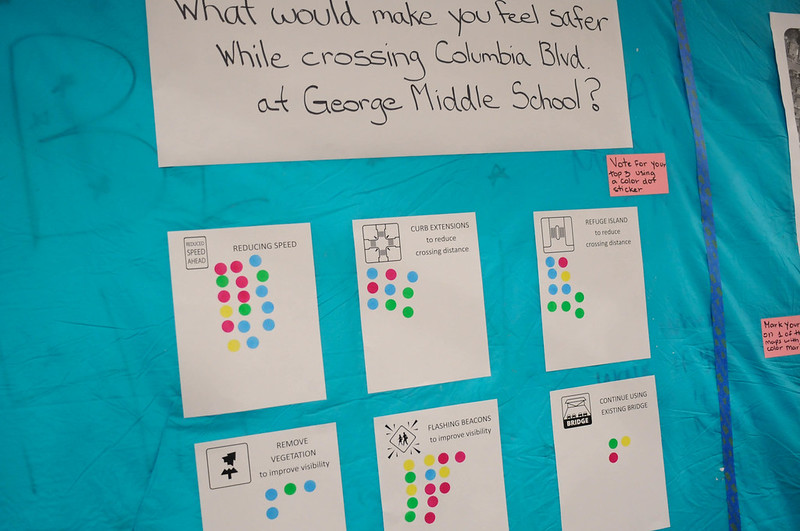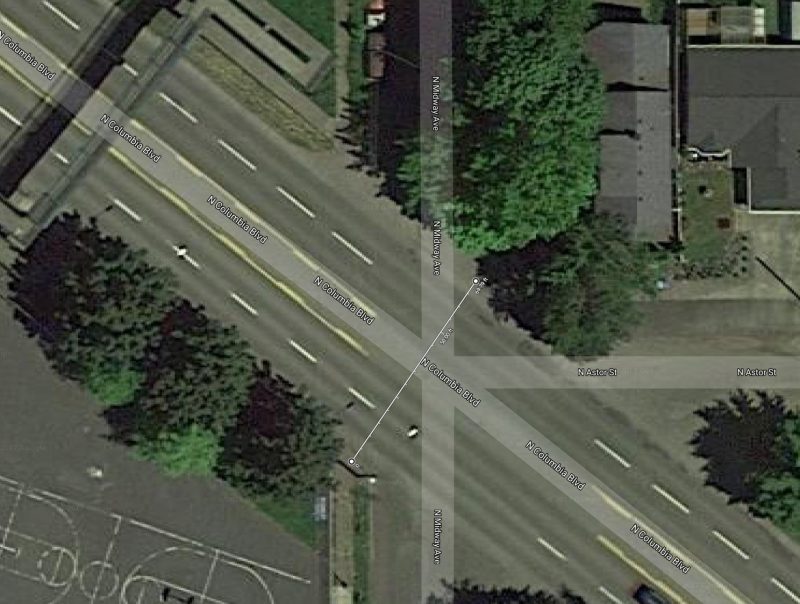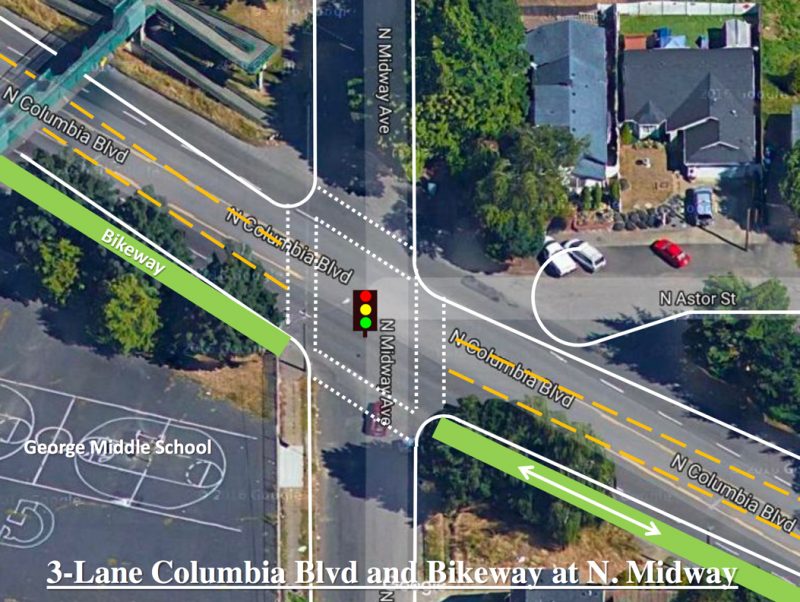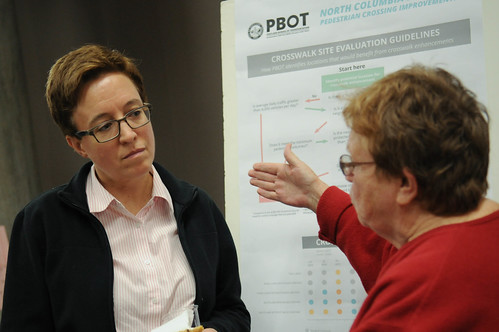
(Photos: J. Maus/BikePortland)
For decades, people who live in a part of St. Johns north of Columbia Boulevard and west of Portland Road have hoped and prayed for street safety improvements. Cut off from nearby schools, markets and restaurants by an urban freeway where people drive large trucks and cars way too fast, residents of this part of our city have been ignored for a long time.
Now, thanks to a $1.5 million set-aside in the recently passed House Bill 2017, changes are finally coming.
Last night at Roosevelt High School the Portland Bureau of Transportation Director Leah Treat, Portland Public Schools Superintendent Guadalupe Guerrero, and Oregon House Speaker Tina Kotek (who represents this area of north Portland) hosted an event to gather input about how to improve safety at the notorious intersection of Columbia and Midway.
“Now we have some money, so let’s make the best use of it.”
— Tina Kotek, state representative
“None of us who live in north Portland need to be reminded we have a lot of accidents out here,” Speaker Kotek said during her brief remarks, “And now we have some money, so let’s make the best use of it.”
Also speaking last night was a sixth grader from nearby George Middle School. “I’m worried my friends will get hurt because of fast trucks,” she said. And a leader of the PTA at Roosevelt High who lives north of Columbia referred to it as, “A neighborhood that’s completely isolated, like a little island.”
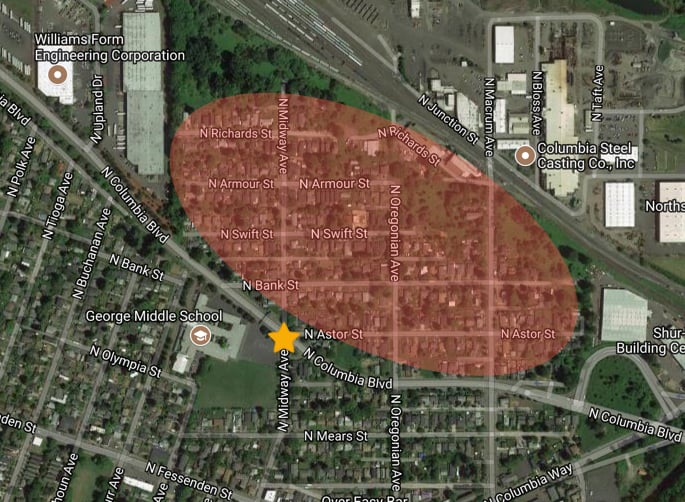
PBOT Director Leah Treat was also in attendance. After saying she, “brought the idea of Vision Zero to the City of Portland” when she became director four years ago, Treat said her agency will request a speed limit reduction on Columbia Blvd and add speed reader boards (signs that tell people how fast they’re going). “We need people to slow down,” Treat told the crowd.
The main focus last night was for people to share feedback on how to make the intersection safer. They did this by having one-on-one conversations with Kotek and city staff around a series of posterboards and interactive displays.
Advertisement
PBOT offered six possible “improvements”: rectangular rapid flash beacon, reduce speed limits, install curb extensions, remove vegetation, install refuge island, and raise the existing, non-motorized bridge overpass. (Noticeably absent from this list were things like a road diet, a roundabout, or a full traffic signal.) According to the amount of dots next to each one, reducing speed limits was the most popular improvement, followed by flashing beacons.
Columbia at Midway is a challenging intersection for many reasons: Depending on where you cross the five daunting lanes, it can be anywhere from 60 to 75-feet from one curb to the other; ibuirgardt’s a major freight route which means the State of Oregon controls much of its fate; Columbia crosses Midway at a diagonal and North Astor (a small residential street) also intersects with it.

I spoke to several people last night who have live north of Columbia. They told harrowing tales.
“One of my friends found a human ear in his yard, and mailed it down to city hall.”
— A man who lives north of Columbia
“It’s a free-for-all,” said one man who has lived in the neighborhood since 1979. He recalled two occasions where he found body parts in the road after a collision. “One of my friends found a human ear in his yard,” he said, “and mailed it down to city hall.” He was very frustrated that nothing has changed with the intersection despite its gruesome history. He and an older woman in her 60s told me the place they’ve lived for over 40 years is often referred to as, “The grey area.” “They don’t know what to do with our streets,” the woman said angrily. “I’m 67 and I have a disability, and I have to walk across Columbia there because I’m too old to use the overpass and there aren’t even sidewalks for me to get to safer crossings.” “There are always meetings like this, but that’s as far as it goes,” the man standing next to her chimed in, “Nothing is going to come from this.”
Trinity Gibbons lives right at the corner of Midway, Columbia and Astor. Gibbons told me she responds to crashes outside her door about twice a month. “It takes seeing someone crash to really understand this. It’s crazy to me.” When she sees kids out in the street, she feels an obligation to tell them to not cross there and use the overpass — but they almost never listen to her. Then she shared a story:
“One weekend there was a whole family out there on bikes. They were lost and looking for Kenton Park (several miles away). I told them to not cross there but they did it anyways. And then there young daughter crashed in the middle of Columbia. I thought, ‘What are we doing here?! This is crazy!’ So I just had to come to this meeting tonight.”
One of Portland’s best transportation thinkers, Jim Howell, was also there last night. He’s shopping around an idea that would tame Columbia for the entire two mile segment between Burgard and Portland Road. Howell’s “Columbia Blvd Safety Plan” (PDF) would: reduce the speed limit to 35 mph (from 40); restripe the road from five standard lanes to three and add a protected, two-way bikeway along the south side; install a traffic signal at Midway (make Astor a cul-de-sac); and improve TriMet bus service. Howell thinks Columbia is “overbuilt” with just 6,000 average daily trips. A high-quality bikeway on Columbia would connect the existing Peninsula Crossing Trail to Chimney and Pier parks and the multi-use path adjacent to Lombard in the Rivergate industrial area that gets people to Kelley Point Park and the 40-mile loop path (see below).
At this point, PBOT is just taking input and it will likely be many months — hopefully not years — before a design is chosen and constructed. And whatever happens is likely to boil down to a persistent nemesis for safer streets throughout Portland: ODOT. The state agency will stand up for “freight interests” if any proposal dares to substantially tame the motorized menace on Columbia.
Stay tuned for more opportunities to get involved as this project moves forward.
— Jonathan Maus: (503) 706-8804, @jonathan_maus on Twitter and jonathan@bikeportland.org
Never miss a story. Sign-up for the daily BP Headlines email.
BikePortland needs your support.


